海明威写作风格手法
- 格式:docx
- 大小:22.62 KB
- 文档页数:7
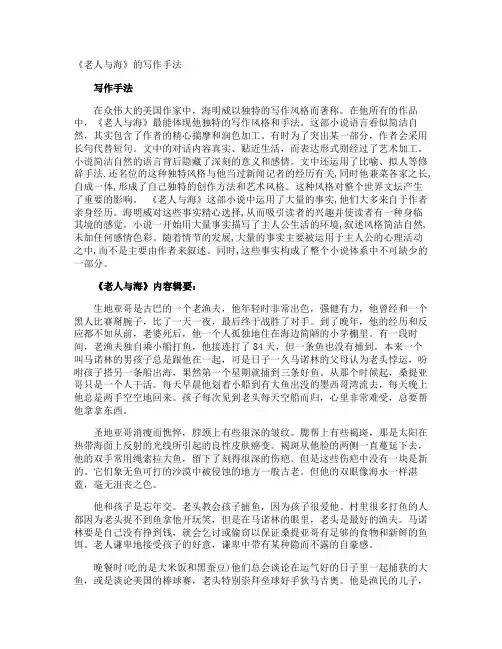
《老人与海》的写作手法写作手法在众伟大的美国作家中,海明威以独特的写作风格而著称。
在他所有的作品中,《老人与海》最能体现他独特的写作风格和手法。
这部小说语言看似简洁自然,其实包含了作者的精心揣摩和润色加工。
有时为了突出某一部分,作者会采用长句代替短句。
文中的对话内容真实、贴近生活,而表达形式则经过了艺术加工。
小说简洁自然的语言背后隐藏了深刻的意义和感情。
文中还运用了比喻、拟人等修辞手法.还名位的这种独特风格与他当过新闻记者的经历有关,同时他兼菜各家之长,自成一体,形成了自己独特的创作方法和艺术风格。
这种风格对整个世界文坛产生了重要的影响。
《老人与海》这部小说中运用了大量的事实,他们大多来自于作者亲身经历。
海明威对这些事实精心选择,从而吸引读者的兴趣并使读者有一种身临其境的感觉。
小说一开始用大量事实描写了主人公生活的环境,叙述风格简洁自然,未加任何感情色彩。
随着情节的发展,大量的事实主要被运用于主人公的心理活动之中,而不是主要由作者来叙述。
同时,这些事实构成了整个小说体系中不可缺少的一部分。
《老人与海》内容辑要:生地亚哥是古巴的一个老渔夫,他年轻时非常出色,强健有力,他曾经和一个黑人比赛掰腕子,比了一天一夜,最后终于战胜了对手。
到了晚年,他的经历和反应都不如从前,老婆死后,他一个人孤独地住在海边简陋的小茅棚里。
有一段时间,老渔夫独自乘小船打鱼,他接连打了84天,但一条鱼也没有捕到。
本来一个叫马诺林的男孩子总是跟他在一起,可是日子一久马诺林的父母认为老头悖运,吩咐孩子搭另一条船出海,果然第一个星期就捕到三条好鱼。
从那个时候起,桑提亚哥只是一个人干活。
每天早晨他划着小船到有大鱼出没的墨西哥湾流去,每天晚上他总是两手空空地回来。
孩子每次见到老头每天空船而归,心里非常难受,总要帮他拿拿东西。
圣地亚哥消瘦而憔悴,脖颈上有些很深的皱纹。
腮帮上有些褐斑,那是太阳在热带海面上反射的光线所引起的良性皮肤癌变。
褐斑从他脸的两侧一直蔓延下去,他的双手常用绳索拉大鱼,留下了刻得很深的伤疤。
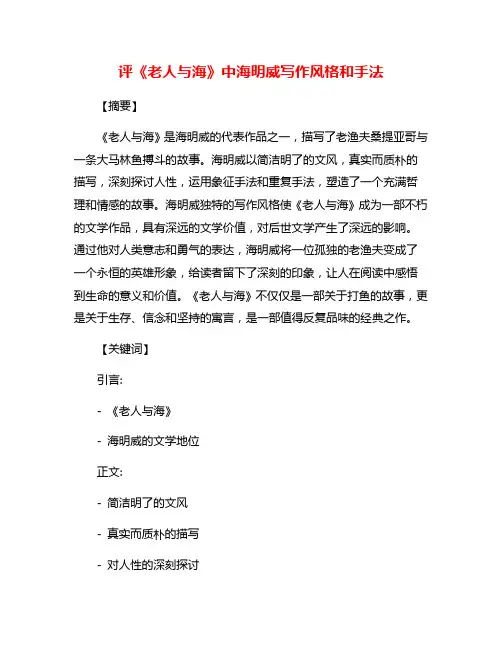
评《老人与海》中海明威写作风格和手法【摘要】《老人与海》是海明威的代表作品之一,描写了老渔夫桑提亚哥与一条大马林鱼搏斗的故事。
海明威以简洁明了的文风,真实而质朴的描写,深刻探讨人性,运用象征手法和重复手法,塑造了一个充满哲理和情感的故事。
海明威独特的写作风格使《老人与海》成为一部不朽的文学作品,具有深远的文学价值,对后世文学产生了深远的影响。
通过他对人类意志和勇气的表达,海明威将一位孤独的老渔夫变成了一个永恒的英雄形象,给读者留下了深刻的印象,让人在阅读中感悟到生命的意义和价值。
《老人与海》不仅仅是一部关于打鱼的故事,更是关于生存、信念和坚持的寓言,是一部值得反复品味的经典之作。
【关键词】引言:- 《老人与海》- 海明威的文学地位正文:- 简洁明了的文风- 真实而质朴的描写- 对人性的深刻探讨- 运用象征手法- 重复手法的运用结论:- 海明威独特的写作风格- 《老人与海》的文学价值- 对后世文学的影响1. 引言1.1 介绍《老人与海》《老人与海》是美国文学家海明威于1952年出版的一部小说,被誉为20世纪最伟大的小说之一。
作品讲述了一个老古巴渔夫与一条大马林鱼搏斗的故事,描写了老人与自然、老人与命运、老人与生命的关系。
海明威以简练、朴实的语言风格,展现了他独特的文学魅力。
小说中充满了对人性的探讨和对生命的思考,展现了一种真实而深刻的生活哲学。
通过对老人与海洋的斗争描写,海明威展现了人与自然、人与命运的对抗,表达了对生命意义的追求和对困境的坚韧不拔。
《老人与海》以其深刻的主题、独特的风格、细腻的描写赢得了广泛的赞誉,被视为海明威文学创作的巅峰之作。
这部小说不仅在文学界产生了深远影响,也为后世的文学创作提供了重要的启示和借鉴。
1.2 海明威的文学地位海明威(Ernest Hemingway)是20世纪20年代至40年代间最杰出的作家之一,被誉为“美国文学的巨星”和“现代文学巨人”。
他在文学界的地位是不可撼动的,拥有众多忠实的读者和拥趸。
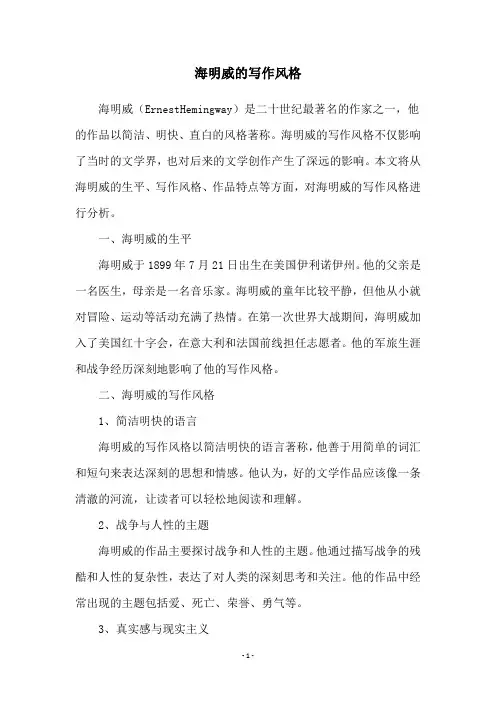
海明威的写作风格海明威(ErnestHemingway)是二十世纪最著名的作家之一,他的作品以简洁、明快、直白的风格著称。
海明威的写作风格不仅影响了当时的文学界,也对后来的文学创作产生了深远的影响。
本文将从海明威的生平、写作风格、作品特点等方面,对海明威的写作风格进行分析。
一、海明威的生平海明威于1899年7月21日出生在美国伊利诺伊州。
他的父亲是一名医生,母亲是一名音乐家。
海明威的童年比较平静,但他从小就对冒险、运动等活动充满了热情。
在第一次世界大战期间,海明威加入了美国红十字会,在意大利和法国前线担任志愿者。
他的军旅生涯和战争经历深刻地影响了他的写作风格。
二、海明威的写作风格1、简洁明快的语言海明威的写作风格以简洁明快的语言著称,他善于用简单的词汇和短句来表达深刻的思想和情感。
他认为,好的文学作品应该像一条清澈的河流,让读者可以轻松地阅读和理解。
2、战争与人性的主题海明威的作品主要探讨战争和人性的主题。
他通过描写战争的残酷和人性的复杂性,表达了对人类的深刻思考和关注。
他的作品中经常出现的主题包括爱、死亡、荣誉、勇气等。
3、真实感与现实主义海明威的作品以真实感和现实主义著称,他善于通过描写细节来表现人物的内心世界和情感,让读者可以深入感受到作品中所描绘的场景和情境。
4、对话和内心独白海明威的作品中经常出现对话和内心独白,他通过这种方式展现了人物的思想和情感,并且让读者可以更加深入地了解人物的性格和行为。
5、短篇小说和小说集海明威的作品主要包括短篇小说和小说集,他善于用简洁的语言和短小的篇幅来表达深刻的思想和情感。
他的作品中经常出现的主题包括爱、死亡、荣誉、勇气等。
三、海明威的作品特点1、《老人与海》《老人与海》是海明威的代表作之一,它讲述了一个老渔夫孤身一人出海捕鱼的故事。
这个故事充满了对生命的探讨和对人性的思考,同时也表现出了海明威的写作风格和艺术风格。
2、《太阳照常升起》《太阳照常升起》是海明威的另一部经典之作,它讲述了一群美国人在巴黎的生活和情感故事。

海明威风格及其原因分析吴定祥黎裕华文学风格是在一系列作品的内容与形式的有机统一中显示出来的。
海明威独特的文学风格,即/海明威风格0在内容上表现为海明威绝大部分作品都是以战争、拳击、斗牛、狩猎、捕鱼等为题材的,通过这些题材,海明威重复着对四大主题,即爱情、孤独、死亡、抗争的描写;作品中的人物形象是那些面对死亡而毫无惧色的硬汉男性形象和作为检验那些男子气概的场所的或/妖女0、或/天使0的女性形象。
在形式上,/海明威风格0表现为/电报式0对话、简洁传情的景物描写、间接心理描写、外聚焦型视角和象征反讽等修辞手法。
这几个方面相辅相成,有机统一,共同构成了对欧美文坛影响深刻的/海明威式0文体风格。
而独特的/海明威风格0的形成与海明威的个性、成长、经历和所处历史时代等密不可分。
一、海明威的写作风格1954年,当瑞典文学院常务秘书安得思#奥斯特林将诺贝尔文学奖授予厄内斯特#海明威时,评价海明威是他那代人的/风格塑造者0,尤其是他/生动的对话0。
海明威一反以亨利#詹姆斯为代表的浮华、曲折的语言风格而在文坛上独树一帜,他的语言简练生动、凝重深厚。
海明威一生奉行的是他自己提出的/冰山原理0。
他在5死在午后6中说:/如果名散文作家对于他写的内容有足够的了解,他也许会省略他懂的东西,而读者还是会对那些东西有强烈的感觉的,仿佛作家已经点明了一样,如果他是非常真实地写作的话。
一座冰山的仪态之所以庄严,是因为它只有八分之一露出水面。
0作品中用文字直接表现出来的部分是读者所能看见的/露出外面的八分之一0,而隐藏在水下的部分则是八分之七,这样的写作原则使得海明威的语言风格具备了以下两个特点。
1.简洁含蓄性海明威的语言以简洁精练著称,他的文字质朴无华,他尽量少用抽象形容词,少写长句子,海明威运用简单的句子和有限的词汇进行有克制的陈述,渲染气氛,暗示读者文字背后有更重要的东西。
另外,他善于从生活中提取那些能够引起读者与之共鸣的细节,按照适当的顺序加以排列和描写,但是他从不遂节铺陈,而是以简练凝重的笔法,客观地勾勒出个个鲜明的人物形象和幅幅生动逼真的生活图画,他不直接披露自己对篇中人物及事件的态度和看法,而是把自己的表情深深地隐藏在字里行间,让读者去观赏玩味、去探索那/藏在海面以下的八分之七0。
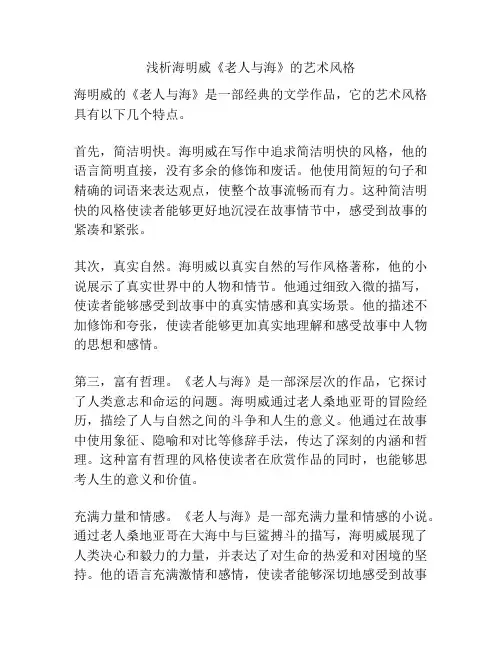
浅析海明威《老人与海》的艺术风格
海明威的《老人与海》是一部经典的文学作品,它的艺术风格具有以下几个特点。
首先,简洁明快。
海明威在写作中追求简洁明快的风格,他的语言简明直接,没有多余的修饰和废话。
他使用简短的句子和精确的词语来表达观点,使整个故事流畅而有力。
这种简洁明快的风格使读者能够更好地沉浸在故事情节中,感受到故事的紧凑和紧张。
其次,真实自然。
海明威以真实自然的写作风格著称,他的小说展示了真实世界中的人物和情节。
他通过细致入微的描写,使读者能够感受到故事中的真实情感和真实场景。
他的描述不加修饰和夸张,使读者能够更加真实地理解和感受故事中人物的思想和感情。
第三,富有哲理。
《老人与海》是一部深层次的作品,它探讨了人类意志和命运的问题。
海明威通过老人桑地亚哥的冒险经历,描绘了人与自然之间的斗争和人生的意义。
他通过在故事中使用象征、隐喻和对比等修辞手法,传达了深刻的内涵和哲理。
这种富有哲理的风格使读者在欣赏作品的同时,也能够思考人生的意义和价值。
充满力量和情感。
《老人与海》是一部充满力量和情感的小说。
通过老人桑地亚哥在大海中与巨鲨搏斗的描写,海明威展现了人类决心和毅力的力量,并表达了对生命的热爱和对困境的坚持。
他的语言充满激情和感情,使读者能够深切地感受到故事
主人公的心灵与生命的挣扎。
海明威的《老人与海》具有简洁明快、真实自然、富有哲理和充满力量和情感等艺术风格。
这些风格使作品成为一部经典之作,深受读者的喜爱和赞赏。
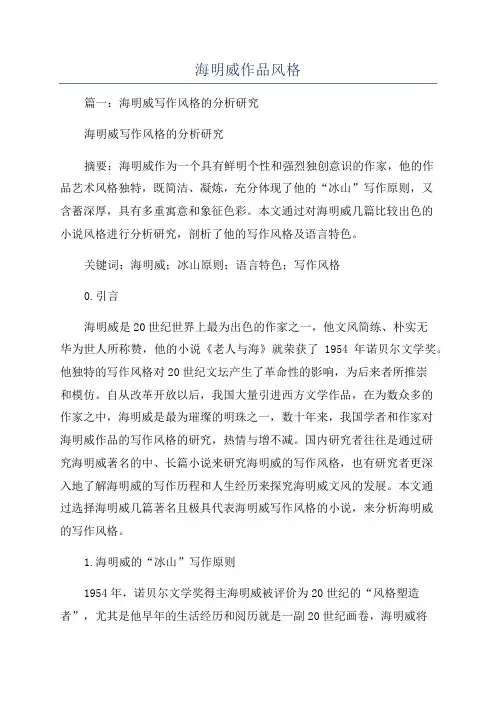
海明威作品风格篇一:海明威写作风格的分析研究海明威写作风格的分析研究摘要:海明威作为一个具有鲜明个性和强烈独创意识的作家,他的作品艺术风格独特,既简洁、凝炼,充分体现了他的“冰山”写作原则,又含蓄深厚,具有多重寓意和象征色彩。
本文通过对海明威几篇比较出色的小说风格进行分析研究,剖析了他的写作风格及语言特色。
关键词:海明威;冰山原则;语言特色;写作风格0.引言海明威是20世纪世界上最为出色的作家之一,他文风简练、朴实无华为世人所称赞,他的小说《老人与海》就荣获了1954年诺贝尔文学奖。
他独特的写作风格对20世纪文坛产生了革命性的影响,为后来者所推崇和模仿。
自从改革开放以后,我国大量引进西方文学作品,在为数众多的作家之中,海明威是最为璀璨的明珠之一,数十年来,我国学者和作家对海明威作品的写作风格的研究,热情与增不减。
国内研究者往往是通过研究海明威著名的中、长篇小说来研究海明威的写作风格,也有研究者更深入地了解海明威的写作历程和人生经历来探究海明威文风的发展。
本文通过选择海明威几篇著名且极具代表海明威写作风格的小说,来分析海明威的写作风格。
1.海明威的“冰山”写作原则1954年,诺贝尔文学奖得主海明威被评价为20世纪的“风格塑造者”,尤其是他早年的生活经历和阅历就是一副20世纪画卷,海明威将他生活的那个时代用文字表达出来,就好像与世界进行“生动的对话”。
海明威写作风格简练、凝练,一反过去那种浮华、冗长、曲折的写作文风,为20世纪文风的革新产生了深远的影响,他本人也成为当代最为欢迎的作家之一。
海明威的写作特点可以用“冰山原理”来形容,所谓“冰山原理”指的是海明威的写作风格力求简洁、生动,用极少的文字表达更多的内容。
正如他在《死在午后》一文中所说:“如果名散文作家对于他写的内容有足够的了解,他也许会省略他懂的东西,而读者还是会对那些东西有强烈的感觉的,仿佛作家己经点明了一样,如果他是非常真实地写作的话。
一座冰山的仪态之所以庄严,是因为它只有八分之一露出水面。
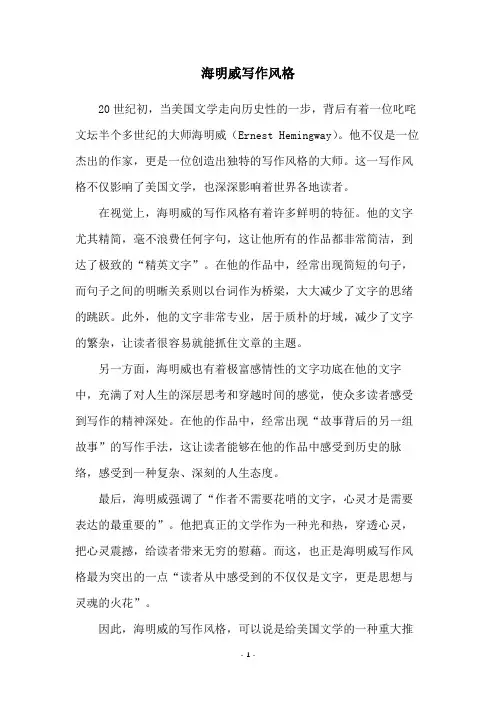
海明威写作风格
20世纪初,当美国文学走向历史性的一步,背后有着一位叱咤文坛半个多世纪的大师海明威(Ernest Hemingway)。
他不仅是一位杰出的作家,更是一位创造出独特的写作风格的大师。
这一写作风格不仅影响了美国文学,也深深影响着世界各地读者。
在视觉上,海明威的写作风格有着许多鲜明的特征。
他的文字尤其精简,毫不浪费任何字句,这让他所有的作品都非常简洁,到达了极致的“精英文字”。
在他的作品中,经常出现简短的句子,而句子之间的明晰关系则以台词作为桥梁,大大减少了文字的思绪的跳跃。
此外,他的文字非常专业,居于质朴的圩域,减少了文字的繁杂,让读者很容易就能抓住文章的主题。
另一方面,海明威也有着极富感情性的文字功底在他的文字中,充满了对人生的深层思考和穿越时间的感觉,使众多读者感受到写作的精神深处。
在他的作品中,经常出现“故事背后的另一组故事”的写作手法,这让读者能够在他的作品中感受到历史的脉络,感受到一种复杂、深刻的人生态度。
最后,海明威强调了“作者不需要花哨的文字,心灵才是需要表达的最重要的”。
他把真正的文学作为一种光和热,穿透心灵,把心灵震撼,给读者带来无穷的慰藉。
而这,也正是海明威写作风格最为突出的一点“读者从中感受到的不仅仅是文字,更是思想与灵魂的火花”。
因此,海明威的写作风格,可以说是给美国文学的一种重大推
动,也受到了全球读者的赞赏。
他的作品不仅创造了“自由简约的文字”,更给读者带来了更多的想象空间,更有更深的思考。
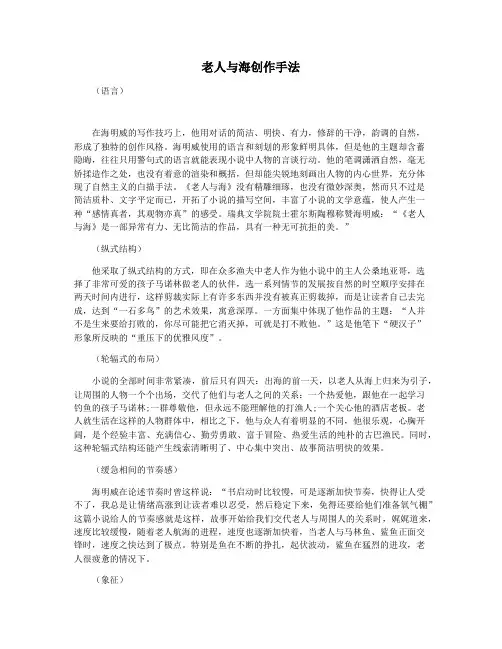
老人与海创作手法(语言)在海明威的写作技巧上,他用对话的简洁、明快、有力,修辞的干净,韵调的自然,形成了独特的创作风格。
海明威使用的语言和刻划的形象鲜明具体,但是他的主题却含蓄隐晦,往往只用警句式的语言就能表现小说中人物的言谈行动。
他的笔调潇洒自然,毫无矫揉造作之处,也没有着意的渲染和概括,但却能尖锐地刻画出人物的内心世界,充分体现了自然主义的白描手法。
《老人与海》没有精雕细琢,也没有微妙深奥,然而只不过是简洁质朴、文字平定而已,开拓了小说的描写空间,丰富了小说的文学意蕴,使人产生一种“感情真者,其观物亦真”的感受。
瑞典文学院院士霍尔斯陶穆称赞海明威:“《老人与海》是一部异常有力、无比简洁的作品,具有一种无可抗拒的美。
”(纵式结构)他采取了纵式结构的方式,即在众多渔夫中老人作为他小说中的主人公桑地亚哥,选择了非常可爱的孩子马诺林做老人的伙伴,选一系列情节的发展按自然的时空顺序安排在两天时间内进行,这样剪裁实际上有许多东西并没有被真正剪裁掉,而是让读者自己去完成,达到“一石多鸟”的艺术效果,寓意深厚。
一方面集中体现了他作品的主题:“人并不是生来要给打败的,你尽可能把它消灭掉,可就是打不败他。
”这是他笔下“硬汉子”形象所反映的“重压下的优雅风度”。
(轮辐式的布局)小说的全部时间非常紧凑,前后只有四天:出海的前一天,以老人从海上归来为引子,让周围的人物一个个出场,交代了他们与老人之间的关系:一个热爱他,跟他在一起学习钓鱼的孩子马诺林;一群尊敬他,但永远不能理解他的打渔人;一个关心他的酒店老板。
老人就生活在这样的人物群体中,相比之下,他与众人有着明显的不同,他很乐观,心胸开阔,是个经验丰富、充满信心、勤劳勇敢、富于冒险、热爱生活的纯朴的古巴渔民。
同时,这种轮辐式结构还能产生线索清晰明了、中心集中突出、故事简洁明快的效果。
(缓急相间的节奏感)海明威在论述节奏时曾这样说:“书启动时比较慢,可是逐渐加快节奏,快得让人受不了,我总是让情绪高涨到让读者难以忍受,然后稳定下来,免得还要给他们准备氧气棚”这篇小说给人的节奏感就是这样,故事开始给我们交代老人与周围人的关系时,娓娓道来,速度比较缓慢,随着老人航海的进程,速度也逐渐加快着,当老人与马林鱼、鲨鱼正面交锋时,速度之快达到了极点。
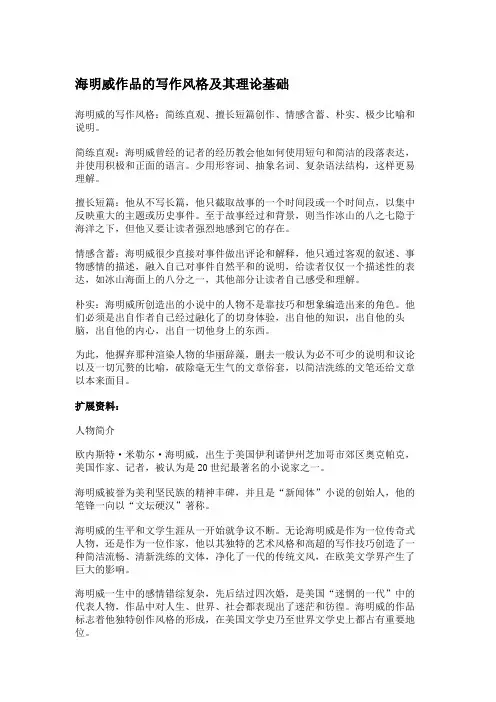
海明威作品的写作风格及其理论基础海明威的写作风格:简练直观、擅长短篇创作、情感含蓄、朴实、极少比喻和说明。
简练直观:海明威曾经的记者的经历教会他如何使用短句和简洁的段落表达,并使用积极和正面的语言。
少用形容词、抽象名词、复杂语法结构,这样更易理解。
擅长短篇:他从不写长篇,他只截取故事的一个时间段或一个时间点,以集中反映重大的主题或历史事件。
至于故事经过和背景,则当作冰山的八之七隐于海洋之下,但他又要让读者强烈地感到它的存在。
情感含蓄:海明威很少直接对事件做出评论和解释,他只通过客观的叙述、事物感情的描述,融入自己对事件自然平和的说明,给读者仅仅一个描述性的表达,如冰山海面上的八分之一,其他部分让读者自己感受和理解。
朴实:海明威所创造出的小说中的人物不是靠技巧和想象编造出来的角色。
他们必须是出自作者自己经过融化了的切身体验,出自他的知识,出自他的头脑,出自他的内心,出自一切他身上的东西。
为此,他摒弃那种渲染人物的华丽辞藻,删去一般认为必不可少的说明和议论以及一切冗赘的比喻,破除毫无生气的文章俗套,以简洁洗练的文笔还给文章以本来面目。
扩展资料:人物简介欧内斯特·米勒尔·海明威,出生于美国伊利诺伊州芝加哥市郊区奥克帕克,美国作家、记者,被认为是20世纪最著名的小说家之一。
海明威被誉为美利坚民族的精神丰碑,并且是“新闻体”小说的创始人,他的笔锋一向以“文坛硬汉”著称。
海明威的生平和文学生涯从一开始就争议不断。
无论海明威是作为一位传奇式人物,还是作为一位作家,他以其独特的艺术风格和高超的写作技巧创造了一种简洁流畅、清新洗练的文体,净化了一代的传统文风,在欧美文学界产生了巨大的影响。
海明威一生中的感情错综复杂,先后结过四次婚,是美国“迷惘的一代”中的代表人物,作品中对人生、世界、社会都表现出了迷茫和彷徨。
海明威的作品标志着他独特创作风格的形成,在美国文学史乃至世界文学史上都占有重要地位。
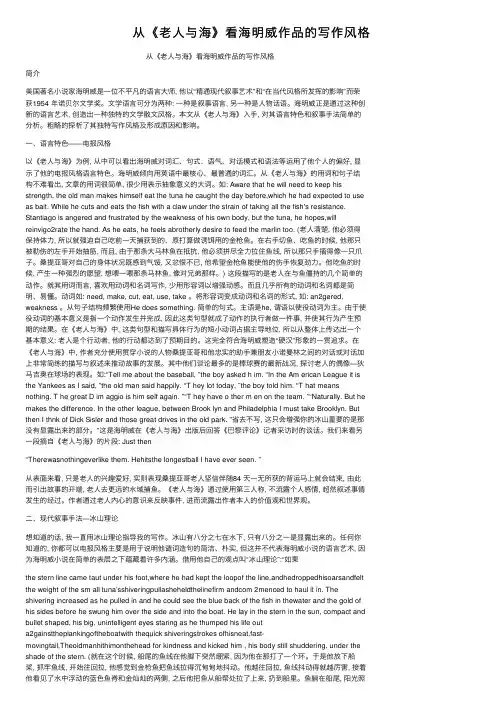
从《⽼⼈与海》看海明威作品的写作风格从《⽼⼈与海》看海明威作品的写作风格简介美国著名⼩说家海明威是⼀位不平凡的语⾔⼤师, 他以“精通现代叙事艺术”和“在当代风格所发挥的影响”⽽荣获1954 年诺贝尔⽂学奖。
⽂学语⾔可分为两种: ⼀种是叙事语⾔, 另⼀种是⼈物话语。
海明威正是通过这种创新的语⾔艺术, 创造出⼀种独特的⽂学散⽂风格。
本⽂从《⽼⼈与海》⼊⼿, 对其语⾔特⾊和叙事⼿法简单的分析。
粗略的探析了其独特写作风格及形成原因和影响。
⼀、语⾔特⾊——电报风格以《⽼⼈与海》为例, 从中可以看出海明威对词汇、句式、语⽓、对话模式和语法等运⽤了他个⼈的偏好, 显⽰了他的电报风格语⾔特⾊。
海明威倾向⽤英语中最核⼼、最普通的词汇。
从《⽼⼈与海》的⽤词和句⼦结构不难看出, ⽂章的⽤词很简单, 很少⽤表⽰抽象意义的⼤词。
如: Aware that he will need to keep his strength, the old man makes himself eat the tuna he caught the day before,which he had expected to use as bait. While he cuts and eats the fish with a claw under the strain of taking all the fish's resistance. Stantiago is angered and frustrated by the weakness of his own body, but the tuna, he hopes,will reinvigo2rate the hand. As he eats, he feels abrotherly desire to feed the marlin too. (⽼⼈清楚, 他必须得保持体⼒, 所以就强迫⾃⼰吃前⼀天捕获到的、原打算做诱饵⽤的⾦枪鱼。
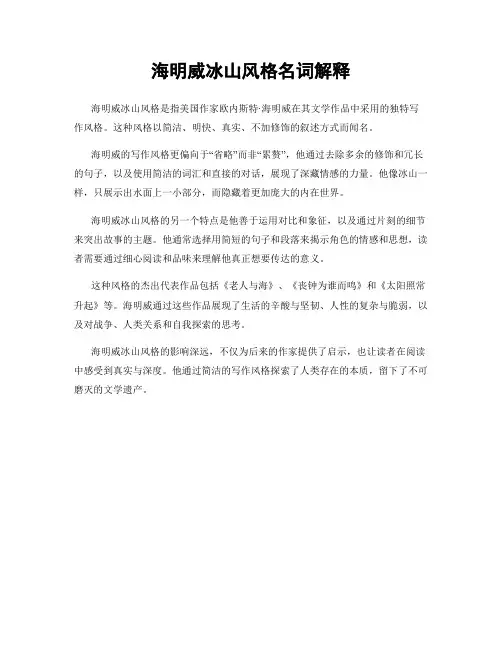
海明威冰山风格名词解释
海明威冰山风格是指美国作家欧内斯特·海明威在其文学作品中采用的独特写作风格。
这种风格以简洁、明快、真实、不加修饰的叙述方式而闻名。
海明威的写作风格更偏向于“省略”而非“累赘”,他通过去除多余的修饰和冗长的句子,以及使用简洁的词汇和直接的对话,展现了深藏情感的力量。
他像冰山一样,只展示出水面上一小部分,而隐藏着更加庞大的内在世界。
海明威冰山风格的另一个特点是他善于运用对比和象征,以及通过片刻的细节来突出故事的主题。
他通常选择用简短的句子和段落来揭示角色的情感和思想,读者需要通过细心阅读和品味来理解他真正想要传达的意义。
这种风格的杰出代表作品包括《老人与海》、《丧钟为谁而鸣》和《太阳照常升起》等。
海明威通过这些作品展现了生活的辛酸与坚韧、人性的复杂与脆弱,以及对战争、人类关系和自我探索的思考。
海明威冰山风格的影响深远,不仅为后来的作家提供了启示,也让读者在阅读中感受到真实与深度。
他通过简洁的写作风格探索了人类存在的本质,留下了不可磨灭的文学遗产。
in another country写作风格《In Another Country》是海明威在1927年所写的一篇短篇小说。
这篇小说的主题是战争和失落,被认为是海明威最令人深思熟虑的作品之一。
在写作风格方面,,海明威以简短、干净、无废话的笔触著称,有着鲜明的个性和风格。
本文将探讨海明威在《In Another Country》中的写作风格。
首先,海明威的写作风格是简约而精致的。
他不使用不必要的修辞和繁琐的表达,而是使用简单的语言和简洁的句子传达信息。
这样的简明风格在小说中表现得淋漓尽致。
例如,当主人公试图重新学习基本的活动时,他用简短的句子描述了他们尝试运动的失败:“我们都转了一百多圈,转了好几个小时。
我们试过了那些练习,没有一个成功。
”这些句子虽简单,但信息传达得很清晰,使读者直接了解主人公的挣扎和沮丧。
其次,海明威的写作风格注重细节。
在《In Another Country》中,他描述了医院内部的环境和情景。
这些细节有助于增强读者对主人公情感困扰的了解,并且让读者感受到强烈的医院气氛。
当主人公与教练交谈时,背景细节描绘了破旧的墙壁和刻有壁龛的大理石地面。
这些细节让读者更加容易地想象出背景和情景,并引起读者的共鸣。
第三,海明威的写作风格充满了情感。
虽然他的语言和句式简单,但他在小说中通过生动的场景和情节,深刻地揭示了主人公内心的情感。
通过主人公的独白,读者了解到他的思想和情感。
例如,当主人公宣布放弃恢复运动能力时,他的内心感到十分沮丧和失望:“我无声地离开他,步行回到酒店。
我是非常沮丧的。
世界上所有的美好东西都已离我远去,就像舞蹈一样,就像生命一样,就像爱一样。
”通过这些情感,读者能够深入地理解主人公的痛苦和失落。
最后,海明威的小说中有很强的思想性质。
他不仅关注故事发生的时间和地点,也探索人物内心的情感和思想。
因此,他的故事不仅仅是旁观者看到的画面,还有着深刻的哲学思考。
当主人公宣布退出治疗时,他的话语掩盖着强烈的绝望和失望。
海明威的极简主义写作风格及其对现代文学的影响概述海明威(Ernest Hemingway)是二十世纪最重要的美国小说家之一。
他以其独特的极简主义写作风格而闻名全球,并对现代文学产生了深远影响。
本文旨在探讨海明威的极简主义写作风格,分析其特点和创作理念,并讨论其如何对现代文学产生积极影响。
1. 极简主义写作风格的特点海明威采用了一种简洁而精确的语言风格,以展示事物与人物之间真实而深刻的情感联系。
以下是海明威极简主义写作风格的一些典型特点:1.1 简洁明了海明威善于用少量的词语表达丰富多彩、生动鲜活的意象。
他避免冗长和复杂的句子结构,以精确和基本描述来传达思想和感情。
1.2 忽略细节海明威倾向于省略细节,只保留最重要、最有实质性的信息。
他相信读者能够通过暗示与间接表达从字里行间中领悟到更多的细节和含义。
1.3 剪裁冲突海明威给予人物大量的内心战斗和冲突,但往往只以简短而有力的方式透露这些情感。
他不过多展示细节,而是让读者通过推断和观察揣摩角色内心世界。
1.4 直击主题海明威的作品通常以一个简单、清晰的主题为核心。
他将重点放在故事情节和深层次思考上,通过写实、现实主义的叙事方法来传递哲学意义。
2. 海明威极简主义写作风格对现代文学的影响2.1 影响另类写作流派海明威对于许多后来出现的文学流派,特别是脚下现代派和后现代派产生了深远影响。
他的简洁而富有诗意的句子结构以及对细节审视和省略的处理方式,启发了许多作家创造出独特、非传统的叙事风格。
2.2 强调内心体验海明威经常探索人性的复杂性和内心的挣扎,他的作品对于现代文学中的自我意识和内在体验有着巨大影响。
许多现代作家从海明威那里汲取灵感,并通过书写个人内心世界来建构角色并展示情感状态。
2.3 启发生活真实海明威通过描绘日常生活中普通人物的故事,强调真实和直接的体验。
这种真实主义的叙事方式激发了许多作家去探索现实生活、底层社会以及社会问题,从而推动了现代文学的进一步发展。
从小说美学角度分析海明威的写作风格【摘要】美国著名小说家海明威是一位不平凡的语言大师,他以“精通现代叙事艺术”和“在当代风格所发挥的影响”而荣获1954年诺贝尔文学奖。
他的作品语言简练,具有电报风格。
其独特的叙事手法被称为“冰山理论”,作品中还大量运用象征来展示深刻的内涵。
本文试图从小说美学的角度分析海明威的作品风格。
【关键词】海明威作品风格电报风格冰山原理象征手法海明威曾经说过,他总是“试图按照冰山的原理”写作。
他的作品,尤其是短篇小说,删除了一切可有可无的东西,把丰富的含义和多样化的形式统一在一个简约的整体结构之中,达到了简约与含蓄的完美结合,形成了独特的写作风格。
一、电报风格电报风格在海明威的小说中无处不在,无论是叙述事实,铺陈景物,对话,还是揭示人物的心理活动,都可见其痕迹。
《老人与海》的语言是简洁的,而所表达的思想又十分深刻,引人深思。
这样不仅揭示了文体的结构关系,也表现了现代艺术的走向和审美情趣——“越少,也就越多”,即语言的表述方式简练客观而节奏迅速,具有电报风格。
如:“老人清楚,他必须得保持体力,所以就强迫自己吃前一天捕获到的、原打算做诱饵用的金枪鱼。
在右手切鱼、吃鱼的时候,他那只被勒伤的左手开始抽筋,而且,由于那条大马林鱼在抵抗,他必须拼尽全力拉住鱼线,所以那只手搐得像一只爪子。
桑提亚哥对自己的身体状况既感到气馁,又忿恨不已,他希望金枪鱼能使他的伤手恢复劲力。
他吃鱼的时候,产生一种强烈的愿望,想喂一喂那条马林鱼,像对兄弟那样。
”这段描写的是老人在与鱼僵持时的几个简单的动作。
就用词而言,海明威喜欢用动词和名词写作,少用形容词,以增强动感,而且几乎所有的动词和名词都简明、易懂。
他倾向用英语中最核心、最普通的词汇。
海明威的简约写作风格,与他早年所接受的锻炼是密不可分的。
1917年高中毕业以后,他没有上大学,而是到《堪萨斯城明星报》去当了一名见习记者。
该报提倡行文明快有力,句段短小;强调新闻的新意、时效、准确、凝练。
海明威写作特点
1、海明威有着出色的语言驾驭能力,他常以最简单的词汇表达最复杂的内容,用基本词汇、简短句式等表达具体含义,用名词、动词来揭示事物的本来面目,丝毫无矫揉造作之感。
2、海明威用高度清晰的视觉化语言,将视觉、嗅觉、听觉等感官印象付诸语言,写出了事物的形状、颜色、味道等,以直接的物象表现宇宙与生命。
3、海明威有自己特殊的艺术风格,他强调写作的客观性与主题思想的隐晦含蓄,反对作者直接出场对人物进行评说与暗示,他常用含蓄的语言表达复杂的情感,用有限的形式表达无尽的内涵,因而,他的小说在外观不动声色,但内在情感却是丰厚炽热。
4、从叙事的方式来看,海明威的小说的对话是“展示”,而不是“讲述”。
它是属于柏拉图所区分的“完美模仿”的一种,而不是“纯叙事”的那种,它想造成一种程度不同的“模仿错觉”,就是“诗人竭力造成不是他本人在说话”,而是某一个人物在说话的假象。
5、从男女关系的主题去分析海明威,不难看出,尽管热衷于描写男人的野性与英勇,海明威却间接表现了他对女人的恐惧与憎恨。
海明威的作品风格分析一、海明威的作品风格特点海明威,美国著名作家,以其独特的写作风格和深刻的情感描写而闻名于世。
他的作品常常流露出简洁、直接和真实的特点,引起了读者们的广泛关注。
本文将从以下几个方面来分析海明威作品的风格特点。
1. 简约而直接一个显著的特点是海明威作品中短小精悍、字句简约而直接。
他倾向于用简单明了的语言来表达自己想要传达给读者的信息。
例如,在《丧钟为谁而鸣》中,他使用了极少量修饰词,使故事更加紧凑有力、生动自然。
这种简洁而直白的方式使得读者能够快速深入地理解故事,并体会到其中所蕴含的情感。
2. 不断强调真实与现实海明威关注现实生活中存在的问题和挑战,并通过他笔下世界各地各行各业中普通人物角色展示人性与命运等主题。
以《老人与海》为例,讲述了一个栩栩如生的古巴老渔夫与他困境中的奋斗。
海明威通过对细节的精确描写,以及对渔夫思想和情感的真实展示,使得读者能够深刻地理解和感受到人类存在的困境与挣扎。
3. 冷静而深邃的观察力海明威以其冷静而深邃的观察力,塑造了许多引人入胜的角色。
他对人物内心动机和情感状态开展了独到的刻画,并将这些隐秘而复杂的情感巧妙地通过故事情节表达出来。
在《归来无期》中,他描述了一个战争英雄在旅途中失去信仰、变得心灵空虚而迷茫的过程。
通过平静而准确地揭示主角内心世界中存在着复杂纠结与痛苦,海明威成功营造出一种恢宏壮丽、耐人寻味的氛围。
4. 淡化个人感情尽管个人情感存在于作品之中,但是海明威通过诸如间接性谈话、突发事件等手法将它们置于次要位置。
他更加关注人类存在的共同经历和普遍价值,并且以此来探寻生命中的真谛。
例如,《别为我哭泣》中,主角表面乐观坚强,但内心却充满对战争残酷现实的痛苦和追求和平的渴望。
海明威通过这种方式将个人情感融入到整个作品中,使之具有深刻而广泛的影响力。
二、海明威的写作风格带来的影响海明威独特的写作风格不仅让他成为美国现代文学史上一位重要的创作家,同时也对当代文学及其他领域产生了广泛而深远的影响。
《永别了,武器》中的写作风格和技巧摘要:在众多伟大的美国作家中,海明威以独特的写作风格而著称。
《永别了,武器》最能体现他独特的写作风格和手法,小说简洁自然的语言背后隐藏了深刻的意义和感情。
这部小说来自于作者亲身经历,它强有力地描述了一战中和一战刚刚结束后的生活,也同样以一种革命的,削减式的风格对其中人物心理复杂性做了极其为生动形象的描写。
一方面,小说如实反映了战后一代人的幻灭和失落,另一方面,文中运用了象征主义手法,来展示现代世界带给人们的失望和悲观情绪。
本文主要从写作技巧和写作风格两个方面分析了海明威的小说《永别了,武器》,以期帮助读者进一步理解这部小说的写作技巧和风格。
关键词:简洁冰山风格创作技巧一、引言在第一次世界大战期间,美国青年弗雷德里克·亨利到意大利北部担任救护车驾驶员,期间与英国护士凯瑟琳·巴克莱相识。
亨利在前线被炮弹炸伤,被送往后方的米兰医院就医。
由于护士紧缺,凯瑟琳也来到了米兰,两人又一次相遇。
亨利发现自己已经深深地爱上了巴克莱小姐。
在米兰就医期间,两人处于热恋之中,度过了一段美好的时光。
这期间,凯瑟琳怀孕了。
亨利伤愈返回前线,发现意军士气大跌,处处充斥着失败与绝望的情绪。
在一座桥前,意军前线宪兵部队开始逮捕所谓擅离职守的军官,并无一幸免地加以枪决,亨利不幸也在其中。
借着审问其他人的时机,亨利跳进河流,得以逃脱被处决的命运。
他终于意识到,自己作为一名士兵的义务已经连同河水一起被冲走了。
此时的他,只有一个目的,那就是找到凯瑟琳,然后两人逃离战争的苦海。
亨利找到凯瑟琳以后,两人再次幸福地相聚。
可是,随后意大利警察的追捕,使得他们不得不逃往瑞士。
亨利和凯瑟琳在瑞士度过了一段幸福的时光,但最终,凯瑟琳还是在难产中死去,留下亨利一人独自在外流亡。
二、写作风格:冰山风格海明威曾说:我总是试图根据冰山原则去写作,水底的部分占整座冰山的八分之七,凡是你知道的东西都可以省略,略去的是海底看不见的部分,这会使你的冰山深厚起来。
评《老人与海》中海明威写作风格和手法AbstractBeing distinguished from many greatest American writers, Hemingway is noted for his writing style. Among all his works, The Old Man and the Sea is a typical one to his unique writing style and technique. The language is simple and natural on the surface, but actually deliberate and artificial. Sometimes the simple style is made a little different. The dialogue is combined with the realistic and the artificial. The simplicity is highly suggestive, and often reflects the strong undercurrent of emotion. Occa sionally, the author uses some figures of speech. Hemingway’s style is related to his experience as a journalist, his learning from many famous writers, and most importantly, his conscientious effort in looking for a style of his own. The influence of his style is great all over the world.The Old Man and the Sea is full of facts, most of which comes from Hemingway’s own experience. So the way to use facts is a very important writing technique in this novel. The facts in the novel are selected and used as a device to make the fictional world accepted. In the forepart of the novel, they are used to show the quality of Santiago’s life, and are narrated simply and naturally; while in the latter part of the novel, they are used from inside Santiago’s own cons ciousness and form part of a whole scheme of the novel.Keywords: Facts; Simplicity; Artificial; Iceberg Theory中文摘要在众伟大的美国作家中,海明威以独特的写作风格而著称。
在他所有的作品中,《老人与海》最能体现他独特的写作风格和手法。
这部小说语言看似简洁自然,其实包含了作者的精心揣摩和润色加工。
有时为了突出某一部分,作者会采用长句代替短句。
文中的对话内容真实、贴近生活,而表达形式则经过了艺术加工。
小说简洁自然的语言背后隐藏了深刻的意义和感情。
文中还运用了比喻、拟人等修辞手法.还名位的这种独特风格与他当过新闻记者的经历有关,同时他兼菜各家之长,自成一体,形成了自己独特的创作方法和艺术风格。
这种风格对整个世界文坛产生了重要的影响。
《老人与海》这部小说中运用了大量的事实,他们大多来自于作者亲身经历。
海明威对这些事实精心选择,从而吸引读者的兴趣并使读者有一种身临其境的感觉。
小说一开始用大量事实描写了主人公生活的环境,叙述风格简洁自然,未加任何感情色彩。
随着情节的发展,大量的事实主要被运用于主人公的心理活动之中,而不是主要由作者来叙述。
同时,这些事实构成了整个小说体系中不可缺少的一部分。
关键词:事实;简洁;加工;冰山理论Hemingway’s Writing Style and Techniques in The Old Man and the SeaIntroductionThe Old Man and the Sea (1952) comes round at the finish of Hemingway’s writing career. With its vivid characterization, its simple language, and the profound implicating it carries, it stands out as one of the excellent books Hemingway’s former stature as the word’s preeminent novelist after Hemingway’s unsuccessful novelAcross the River and into the trees (1950). The Old Man and the Sea earned its author the Pulitzer Prize in fiction for 1952, and was instrumental in winning him the Nobel Prize for Literature two years later. It is a short novel about Santiago, an old Cuban fisherman who has gone for 84 days without catch. Therefore the boy, Mandolin, who used to sail with him, is forced to leave him and catch in another ship. The old man insists on fishing alone and at last, he hooks an eighteen-foot, giant marlin, the largest he has ever known. But the fish is very powerful and disobedient. It tows the old man and his boat out to sea for 48 hours, with the old man bearing the whole weight of the fish through the line on his back. The old man, with little food and sleep, has to endure much pain and fights against his treacherous hand cramp. To his great excitement, on his third day at sea, he succeeds in drawing the weakened marlin to the surface and harpoons it. On his way home, he lashes marlin alongside his boat because it is too big to be pulled into the boat. But, unfortunately, the come across sharks in different numbers for four times. The old man fights to kill the sharks with as much might and many weapons as he can summon, but only to find a giant skeleton of his marlin left after his desperate defense. At last, Santiago, having lost what he fought for, reaches the shore and struggles to his shack. He falls into sound sleep, dreaming of Africa, and the lions again. His struggle wins him much respect.Among many great American writers, Hemingway is famous for his objective and terse prose style. As the last novel Hemingway published in his life, The Old Man and the Sea typically reflects his unique writing style. This paper aims to discuss the writing style and techniques in The Old Man and the Sea. Of course, Hemingway has used many techniques in this novel, such as realism, the creation of suspense, monologue, etc. And this paper focuses especially on the language style and one of the important techniques-the way to use facts in this novel.Hemingway is famous for his language. With much care and effort, he created a very influential and immediately recognizable style. “The style he created in his early work, such as In Our Time and The Sun also Rises, was almost too good. Like the style of certain painters, it tended to become a manner, rather than a flexible way of responding to experience and conveying fresh insights through words.”1 Among all his works, The Old Man and the Sea is the most typical one to his unique language style. Its language is simple and natural, and has the effect of directness, clarity and freshness. This is because Hemingway always manages to choose words “`concrete, specific, more commonly found, more Anglo-Saxon, casual and conversational.” 2 He seldom uses adjectives and abstract nouns, and avoids complicated syntax. Hemingway’s strength lies in his short sentences and very specific details. His short sentences are powerfully loaded with the tension, which he sees in life. Where he does not use a simple and short sentence, he connects the various parts of the sentence in a straightforward and sequential way, often linked by “and”.In his task of creating real people, Hemingway uses dialogue as an effective device. It is presented in a form “as close to the dramatic as pos sible, with a minimum of explanatory comment.”3 Here is an example chosen from The Old Man and the Sea: ‘What do you have to eat?’ the boy asked.‘No, I will eat at home. Do you want me to make the fire?’‘No, I will make it later on. Or I may eat the rice cold.’Here we can see that such interpolations as “he said” have frequently been omitted and the words are very colloquial. Thus the speech comes to the reader as if he were listening. Hemingway has captured the immediacy of dialogue skillfully and has made the economical speech connotative.But it is good to note that Hemingway’s style is deliberate and artificial, and is never as natural as it seems to be. The reasons are as follows. Firstly, in some specific moments, in order to stand out by contrast and to describe an important turning point or climax, the style is made a little different:He took all his pain and what was left of his long gone pride and he put it against the fish’s agony and the fish came over on to his side and swam gently o n his side, his bill almost touching the planking of the skiff, and started to pass the boat, long, deep, wide, silver and barred with purple and interminable in the water.5The language in this one-sentence paragraph is different from other parts of the novel. Kenneth Graham has commented that the sentence builds up its parts in a carefully laborious sequence-“all his pain and what was left of his strength and his long gone pride”. It emulates the movement of the exhausted marlin and the physical strain of the old man. And it mounts to a heavy crescendo in the very un-prosaic inversion of adjectives-“long, deep, wide”-ending in the virtually poetic cadence, “interminable in the water.”6The dialogue, too, is combined with the realistic and the artificial. Usually the content contains and the expression contains the artificial. In The Old Man and the Sea, the language style is very peculiar from Hemingway’s other writings. This is because the novel is an English version of the Spanish that Santiago and Mandolin would speak in real life. “Since we are meant to realize that Santiago and Mandolin could not possibly speak like this, since English is not his tongue anyway, we are more likely to accept other artificialities of the dialogue. Using the device of a pretended ‘translation’, which would be bound to stilt in any case, Hemingway can ‘poetize’ the dialogue as he wishes.”7 The speakers are distanced from readers to a certain degree. And while their language taking on a kind of epic dignity, it does not lose its convincingness. Even slightly strange exchanges like the following become fairly acceptable. For example:‘You’re my alarm clock’, the boy said.‘Age is my alarm clock’, the old man said. ‘Why do old man wake so early? Is it to have one longer d ay?’‘I don’t know’, the boy said. ‘All I know is that young boys sleep late and hard’.‘I can remember it’, the old man said. ‘ I’ll waken you in time.’8The simple sentences and the repeated rhythms hit at the profundities that the surface of the language tries to ignore. Its simplicity is highly suggestive and connotative, and often reflects the strong undercurrent of emotion. Indeed, the more closely the reader watches, the less rough and simple the characters appear. In Death in the Afternoon, Hemingway uses an effective metaphor to describe his writing style:If a writer of the prose knows enough about what he is writing about, he may omit things that he knows and the reader, if the writer is writing truly enough, will have a feeling of those things as strongly as though the writer had stated them. The dignity of movement of an iceberg is due to only one-eighth of it being above water.9 Among all the works of Hemingway, the saga of Santiago is thought as the most typical one to this Iceberg Theory. The author seldom expresses his own feelings directly, nor does he make any comments or explanations. On the contrary, he tries to narrate and describe things objectively and blend his own feelings harmoniously to the natural narration and description this gives readers a pictures compression, from which-the 1/8 of the iceberg above water, they can learn the implying meaning and feelings of the author- 7/8 of the iceberg under water. When Hemingway said of this story, “I tried to make a real old man, a real sea and real sharks”, he then went on to say, “But if I made them good and true enough they would mean many things.”10 So this novel has a great and significance conveyed by a compressed action. The core of the novel’s action is fishing. To the he ro, fishing is not simply of contest in life. It contains profound philosophic meaning. In addition, two details-the baseball match and the hand wresting with the Negro, like fishing, symbolize the contention in life. They compensate and enrich the inner meaning of the main plot of fishing. So the simplicity of the novel is highly suggestive.Occasionally, the author uses such figures of speech as metaphor, personification, etc to describe details. Hemingway likes to us natural things to make metaphors. For example, he describes Santiago’s eyes as “the same color as the sea and were cheerful and undefeated.”11The metaphor reveals that the old man is closely linked with nature. At the beginning of the novel, a simile is used: “the sail was patched with flour sacks and, furled, it looked like the flag of permanent defeat.”12 Here Santiago’s eyes are contrasted with the patched sail, which symbolize defeat, as reveals Santiago’s unyielding character.So Hemingway has formed of narrative and dialogue, though natural and simple on the surface, is actually deliberated and artificial. It combines elements that are realistic with elements that are stylized and heightened.How Hemingway has formed such a writing style? The reason is related to his own experiences. “His use of short sentences and paragraphs and vigorous and positive language, and the deliberate avoidance of gorgeous adjectives are some of the traces of his early journalistic practices.”13 After leaving school at 17, he went to the Kansas City Star, which was one of the best newspapers in America at that time. He served as its eager and energetic reporter. As a journalist, Hemingway trained himself in the economy of expression. He once said that, during his working in Star, he had to learn to use simple sentences, which is very useful to him; and that the experience of working as a journalist would not do harm to a young writer, instead it is very helpful if he could cast it off timely. He laid stress on “speaking” with facts and objected groundless concoction in writing. His descriptions of details are full of factuality, and are as precise as news reports.The influence of Hemingway’s language style is great. In the latter part of his life, Hemingway was known as “Papa Hemingway.”14 It refers mainly to his contributionto the development of a new writing style in America-the colloquial style. His simple word, short sentences and vividly colloquial language purity American novel. In England, which Miss Storm Jameson discussing “The Craft of the Novelist”in the January 1934 issue of The English Review, she advanced an explanation of Hemingway’s popularity:It is this simplicity, this appeal to our crudest interests, which explains Hemingway’s success...In English at least his success has been largely with the intellectuals. Thy have praised his simplicity, his directness (15)When Hemingway’s death was reported on 3 July 1961, the obituary in The Tines pronounced pontifically:No history of the literature of our time will be able to ignore his achievement or his far-reaching influence...his last masterpiece, The Old Man and The Sea, he remained a solitary both in achievement and style (16)And Hemingway’s influence as a stylist was “neatly expressed in the praise of the Noble Prize Committee about ‘his powerful style-forming mastery of the art’ of writing modern fiction.”17Apart from the language style, which The Old Man and the Sea is famous for, the writing techniques in this novel are also worth paying close attention to. A very important one of them is the way to use facts. The main events of the story seem to be based on a real incident, which is described by Hemingway in an article about fishing in the Gulf Stream in Esquire for April 1936. So the novel of full facts, such as the habit of fish, the technique of catching marlin, the weather, the sea, and so on. But the power of the novel lies in the way to use these facts.Firstly the facts are selected. “Hemingway’s old man, boy, sea, fish, and sharks are not so much built up in our minds, detail by detail, facts by facts, as drive into our mind by the force and the sympathy with which the author himself shares in their imaginary existence.”18 Like any realist, he relies on selection. When the giant marlin finally surfaces, his tail “was higher than a big scythe blade and a very pale lavender above the dark blue water.”19 Sargasso weed is bleached and yellow by day; Tuna are silver when they jump out if the water, but blue-backed and gold-sides when swimming. Hemingway never described them with excessively, but choose some effective ones. He uses them with a sense of how colors shift and change in their relationship. Without selection, there can be no intensity, and compression. Secondly, the facts are used as a device to make the fictional word accepted. The novel is not simply a manual for us to study the technique to catch a fish or how to survive in a boat. The author tries to implicate people’s imagination in what is happening by appealing to our love of practical knowledge. This shows “the facts are f undamentally a device, a technique of reassuring our sense of everyday values.”20 So they can help to make us accept more readily what the author has invented and made more dramatic than in everyday life. Still take the use of color as example:The clouds over the land now rose like mountains and the coast was only a long green line with the gray-blue hills behind it. The water was a dark blue now, so dark that it was almost purple. As he looked down into it he saw the red sifting of the plankton in the dark water and the strange light the sun made now.21These facts show readers the process of fishing, which mostly comes from the author’s own experience. From these facts, which are vivid, precise and terse, readers can learn a lot about how to catch a fish and can also feel as if they themselves were catching a fish. Then they will have the sense that what the author describes is real and believable. Therefore, as Kenneth Graham has said, many facts in the novel about fishing and about the sea have a double function: they satisfy people’s sense of the real word. And this is what underlies Hemingway’s famous statement that his intention was always to convey to the reader “the way it was.”22 All in all, Hemingway’s language in The Old Man and the Sea is simple and natural on the surface, but actually deliberate and artificial. “The language is rarely emotional. Rather, it controls emotions: it holds them in.”23 The forming of this distinct style is related to Hemingway’s own experience. And the influence of this style is not only within America but also all over the world. The facts in the novel are selected and used as a device to make the fictional world accepted. Unlike other novelists who add allegorical meanings to their facts, Hemingway uses the facts simply and naturally, without any emotion. In the latter part of the novel, instead of being narrated by the author, the facts are used from inside Santiago’s own consciousness, and form part of a whole scheme of the novel. Besides what have been mentioned above, other techniques in The Old Man and the Sea, such as realism, monologue, the creation of suspense and so on, are also very successful. All these show Hemingway’s superb artistic attainments as a Nobel Prize winner. Notes:1. Kenneth Gr aham, “commentary” in York Notes: The Old Man and the Sea, (Beijing: world Publishing Corporation, 1991), p412. Chang Yaoxin, “Chapter 14” in A Survey of American Literature, (TianJin: Nankai University Press, 1987), p3043. Mary A. Campbell, “Study Guide” in The Old Man and the Sea, (Beijing: world Publishing Corporation, 1998), p1264. Ernest Hemingway, The Old Man and the Sea, (Beijing: world Publishing Corporation, 1998), p85. Ibid, p836. Kenneth Graham, “commentary” in York Notes: The Old Man and the Sea, (Beijing: world Publishing Corporation, 1991), p427. Ibid, p458. Ernest Hemingway, The Old Man and the Sea, (Beijing: world Publishing Corporation, 1998), p209. Ernest Hemingway, Death in the Afternoon, (New York, 1932), p13810. Times, 13 December 1954.11. Ernest Hemingway, The Old Man and the Sea, (Beijing: world Publishing Corporation, 1998), p212. Ibid, p113. Chang Yaoxin, “Chapter 14” in A Survey of American Literature, (TianJin:Nankai University Press, 1987), p29514. A.E.Hotchner, Papa Hemingway, (New York: Random House, 1966), p115. Roger Asselineau, ed, “Hemingway’s English Reputation” in The Literary Reputation of Hemingway in Europe, (New York: New York University Press, 1965), p1516. Ibid, p1017. Chang Yaoxin, “Chapter 14” in A Survey of American Literature, (TianJin:Nankai University Press, 1987), p30518. Kenneth Graham, “commentary” in York Notes: The Old Man and the Sea, (Beijing: world Publishing Corporation, 1991), p2519. Ernest Hemingway, The Old Man and the Sea, (Beijing: world Publishing Corporation, 1998), p7920. Kenneth Graham, “commentary” in York Notes: The Old Man and the Sea, (Beijing: world Publishing Corporation, 1991), p2921. Ernest Hemingway, The Old Man and the Sea, (Beijing: world Publishing Corporation, 1998), p2622. Kenneth Graham, “commentary” in York Notes: The Old Man and the Sea, (Beijing: world Publishing Corporation, 1991), p2923. Peter B. High, “Chapter 11” in An Outline of American Literature, (New York: Long man Inc., 1986), p147Bibliography:1. Chang Yaoxin, “Chapter 14” in A Survey of American Literature. TianJin:Nankai University Press, 19872. Kenneth Graham, “commentary” in York Notes: The Old Man and the Sea. Beijing: world Publishing Corporation, 19913. Ernest Hemingway, The Old Man and the Sea. Beijing: world Publishing Corporation, 19984. 崔道怡等编.《“冰山”理论:对话与潜对话》工人出版社,1987.5. 刁绍华. 《海明威》. 辽宁人民出版社, 1980.6. 傅景川. 《二十世纪美国小说史》. 吉林教育出版社, 1996。